The Drought-Stricken South
Air Date: Week of October 26, 2007
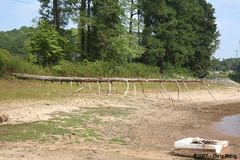
(Photo: (C)2007 Chris Rabig)
Southern states in the U.S. are living through a record-breaking drought. Lakes and rivers are running dry which pits the demands of cities against endangered shellfish and fishermen. Living on Earth’s Steve Curwood speaks with Andrew Smith, executive director of the Apalachicola Riverkeeper. But there are strong efforts to conserve scarce water. Bruce Gellerman learns what the University of Georgia at Athens is doing from Todd Rasmussen, UGA professor of hydrology and water resources.
Transcript
STEVE: It’s Living on Earth. I’m Steve Curwood.
GELLERMAN: And I’m Bruce Gellerman. Just ahead: “For What It’s Worth,” Bonnie Raitt steps up to the plate again to speak out against nukes. But first—unlike the raging fires scorching California, the drought in seven southeastern states is a disaster in slow motion. Over the past year and a half sweltering heat and historic low levels of rainfall have wreeked havoc on the region.
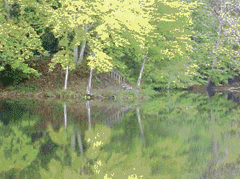
Officials in Monteagle are considering setting up portable water filtration systems on local lakes such as this one to alleviate the drought.(Photo: Monteagle, Tennessee Chamber of Commerce)
ROLLINS: Our reservoir is virtually dried up. We’re holding just a little bit of reserve in case of a major break or a major fire. We are purchasing all the water that we use, about 350,000 gallons a day, from three different utilities. We were put on notice yesterday that the supply may not last but two or three more weeks and it’s put us scrambling to find out what we’re going to do in the near future.
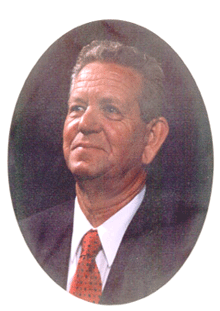
Charles Rollins, Mayor of Monteagle, Tennessee.(Photo: Monteagle, Tennessee Chamber of Commerce)
CURWOOD: The scarcity of precious water has pitted state against state. Lake Lanier in Atlanta is running dry—yet every day the feds release a billion gallons down river, in part to protect threatened shellfish in Florida. Georgia wants to keep its water and is seeking an injunction to suspend the Endangered Species Act. But in Florida, Andrew Smith, who’s the executive director of the Apalachicola Riverkeeper, says jobs are at stake.
SMITH: We produce 13 percent of the nation’s oysters. Those oystermen, out there on the water, are telling us that when they tong up the oysters, 50 percent of them that they’re pulling up are dead. And what you have when you have less freshwater in the bay, you have more saltwater from the Gulf and you have predators like oyster drills and conchs that come and actually predate on the oysters and can decimate an oyster bed.
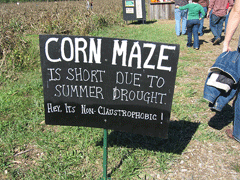
There's nothing corny about this sign at a corn field in Tennessee. (Courtesy of Flickr/ library_chic)
SMITH: What we’re actually seeing is a transition from a pure floodplain wetland system to more of an upland system. The actual plant species are changing. And with less water in the flood plain, which is a wonderful habitat for fish to spawn, we’re having, you know, less opportunities for those species—those fish and other species—to go in there and spawn. So we’re seeing decreased crawfish populations and things like that.
CURWOOD: Now I understand there are some endangered water species there in the Apalachicola. How is the water flow affecting them?
SMITH: There are two endangered mussel species of concern and that’s the purple bankclimber and the three-fat ridge mussel. Those are dependent on there being enough water in the floodplain as well and preliminary reports that we are getting back from scientists looking at the populations there is that there’s a significant amount of mortality in those mussel populations this year due to the decreased flows.
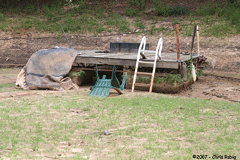
No diving any time soon off of this swim platform in Lake Lanier. (Photo: (C)2007 Chris Rabig)
SMITH: Steve, I don’t think it’s necessary at all. In fact, I think it’s really bad policy. We feel like Georgia is just trying to change federal law when it doesn’t suit them. The mussels didn’t create this crisis. In fact, this crisis wasn’t created by the drought. The crisis came from Atlanta’s failure to conserve water, and its failure to control growth. That’s what’s creating the crisis.

Lake Lanier, Metropolitan Atlanta's main source of water, is drying up. This tree on the lake shoreline is normally underwater. (Photo: (C)2007 Chris Rabig)
CURWOOD: Andy Smith is the executive director of the Apalachicola Riverkeeper. Thanks so much, Andy.
ANDY: You’re welcome, Steve. I’m happy to be able to talk to you.
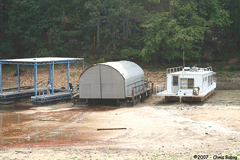
These boats usually float in ten feet of water in Lake Lanier. (Photo: (C)2007 Chris Rabig)
NGUYEN: We do actually have people turning in their neighbors. We’re typically getting about 250 to 400 calls a day. Last week we did have to call the police in twice. We had two separate incidents where the customers were on site and refused to terminate irrigation and actually made physical threats to our staff.
GELLERMAN: One of the largest users of water in Georgia is the state university at Athens, where officials wants to cut consumption by a quarter. Todd Rasmussen, professor of hydrology and water resources at UGA, says there are already changes on campus.
RASMUSSEN: Well, they’ve turned off the outdoor watering systems. The irrigation is off. All the fountains have been drained. The chillers that help air-condition the buildings have been turned down so that there’s less water used in air conditioning, which means the buildings are maybe a little warmer.
GELLERMAN: Now I understand that you’re retrofitting your auto-flush toilets?
RASMUSSEN: The auto-flush toilets have been a problem. They tend to flush with their own sense of mission and they tend to flush too often. We find that the dorms are taping some of the flushing devices closed. There’s somewhat of a competition going on in the dorms to try and save water. They keep track of how much water the students use in dorms and so to get an award they’re trying to reduce as much as possible.
GELLERMAN: I went to your website and you’ve got this fabulous picture of purple pipes. What’s that?
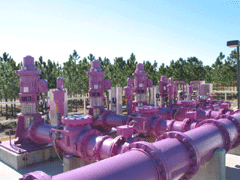
Purple pipes to carry reclaimed water have been installed in many of the city of Clermont's newer subdivisions. The purple color warns plumbers that they are not drinking water. (Courtesy of the City of Clermont, FL)
GELLERMAN: Do you think there could be a silver lining in this cloud—that is, you know, once the drought is over you’ll be conserving more water?
RASMUSSEN: Absolutely. I think these are long-term habits we’re trying to promote. The other thing we’re trying to point out is that when you save water, you’re saving electricity. One of the major uses of water on campus is air conditioning and so, by setting the thermostat a little warmer you’re saving a lot of water and you’re also saving a lot of electricity and so we all need to conserve these days. So there’s so many different benefits we’re effecting by this.
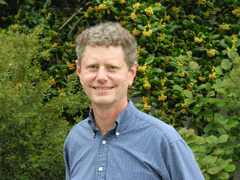
Todd Rasmussen is Professor of Hydrology and Water Resources at the Warnell School of Forestry and Natural Resources of the University of Georgia, Athens.
RASMUSSEN: Well I was in the Peace Corps in Honduras and so we only had water a few hours every day and so you begin to sort of, count the water. So this ‘every drop counts’ is to focus people on ‘how much water do you actually use in a day?’ And when you’re filling buckets from the sink you get a certain sense about how much water you’re wasting. And that’s the one comment I’ve heard from a lot of people was that they didn’t realize just how much water they were using and I think we could dramatically decrease the amount and our impact, our hydrologic footprint so to speak on our community, by just trying to be aware of where you use water, how you use it, and how you might do better in conserving this resource.
GELLERMAN: Todd Rasmussen is professor of hydrology and water resources at the University of Georgia Athens. Professor, thank you very much.
CURWOOD: Well, thank you Bruce.
Links
Living on Earth wants to hear from you!
Living on Earth
62 Calef Highway, Suite 212
Lee, NH 03861
Telephone: 617-287-4121
E-mail: comments@loe.org
Newsletter [Click here]
Donate to Living on Earth!
Living on Earth is an independent media program and relies entirely on contributions from listeners and institutions supporting public service. Please donate now to preserve an independent environmental voice.
NewsletterLiving on Earth offers a weekly delivery of the show's rundown to your mailbox. Sign up for our newsletter today!
 Sailors For The Sea: Be the change you want to sea.
Sailors For The Sea: Be the change you want to sea.
 The Grantham Foundation for the Protection of the Environment: Committed to protecting and improving the health of the global environment.
The Grantham Foundation for the Protection of the Environment: Committed to protecting and improving the health of the global environment.
 Contribute to Living on Earth and receive, as our gift to you, an archival print of one of Mark Seth Lender's extraordinary wildlife photographs. Follow the link to see Mark's current collection of photographs.
Contribute to Living on Earth and receive, as our gift to you, an archival print of one of Mark Seth Lender's extraordinary wildlife photographs. Follow the link to see Mark's current collection of photographs.
 Buy a signed copy of Mark Seth Lender's book Smeagull the Seagull & support Living on Earth
Buy a signed copy of Mark Seth Lender's book Smeagull the Seagull & support Living on Earth

